Sentence Completion được đánh giá là một dạng bài khó đối với phần lớn thí sinh mới bắt đầu luyện thi IELTS Reading. Với yêu cầu về điền từ, cụm từ chính xác vào các khoảng trống trong câu hỏi, dạng bài IELTS Reading Sentence Completion đòi hỏi thí sinh phải có kỹ năng đọc hiểu tốt và hiểu rõ ngữ cảnh của đoạn văn. Vậy làm thế nào để làm tốt dạng bài này? Cùng IELTS Thanh Loan tìm hiểu chi tiết cách làm bài IELTS Reading Sentence Completion qua bài viết dưới đây nhé!
Dạng bài Sentence Completion là gì?
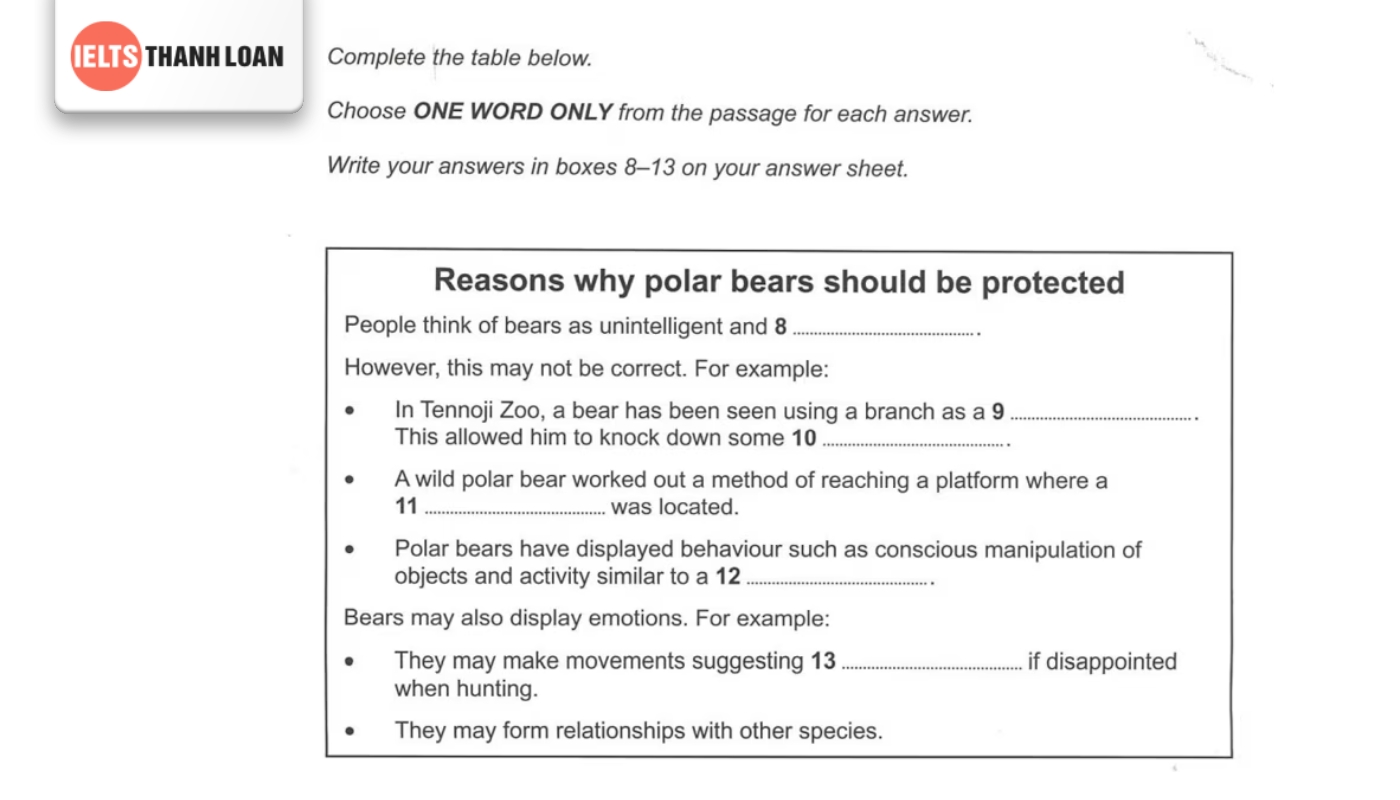
Sentence Completion Questions là gì trong IELTS Reading?
IELTS Reading Sentence Completion Questions là dạng bài yêu cầu thí sinh hoàn thành câu văn bằng cách điền từ, cụm từ thích hợp vào chỗ trống dựa trên thông tin từ bài đọc. Thông thường, đề bài Sentence Completion IELTS Reading sẽ đưa ra từ 3 – 6 câu hỏi. Để làm bài, thí sinh cần dựa vào thông tin từ bài đọc và chọn lọc từ vựng phù hợp để hoàn thiện câu.
- Mục đích: Đánh giá khả năng đọc hiểu nội dung tổng quát và chi tiết của thí sinh đối với văn bản tiếng Anh.
- Lưu ý: Một lưu ý quan trọng khi làm dạng bài Sentence Completion là đề bài sẽ quy định số từ tối đa mà bạn được phép điền vào chỗ trống, chẳng hạn như “NO MORE THAN TWO WORDS” (Không điền quá 2 từ). Nếu không tuân thủ yêu cầu đề bài, câu trả lời của thí sinh sẽ không được tính điểm.
Cách làm bài IELTS Reading Sentence Completion
Để làm tốt Sentence Completion một dạng bài IELTS Reading tương đối khó, thí sinh cần có chiến lược làm bài khoa học với các bước cụ thể như sau:

Cách làm dạng bài Sentence Completion trong IELTS Reading
Bước 1: Đọc và hiểu yêu cầu đề bài
Trước tiên, thí sinh hãy đọc thật kỹ yêu cầu đề bài và lưu ý cụm từ in đậm. Đây là cụm từ cho biết bạn sẽ được phép điền bao nhiêu từ, cụm từ vào chỗ trống. Để tránh mất điểm khi làm bài, bạn chỉ nên điền từ đúng với giới hạn quy định mà đề bài yêu cầu.
Ví dụ:
- ONE WORD ONLY: Chỉ điền một từ duy nhất.
- NO MORE THAN TWO WORDS: Bạn có thể điền 1 hoặc 2 từ, nhưng không được vượt quá 2 từ. Nếu những từ có dấu gạch nối như time-saving hoặc life-changing thì chúng sẽ được tính là 1 từ.
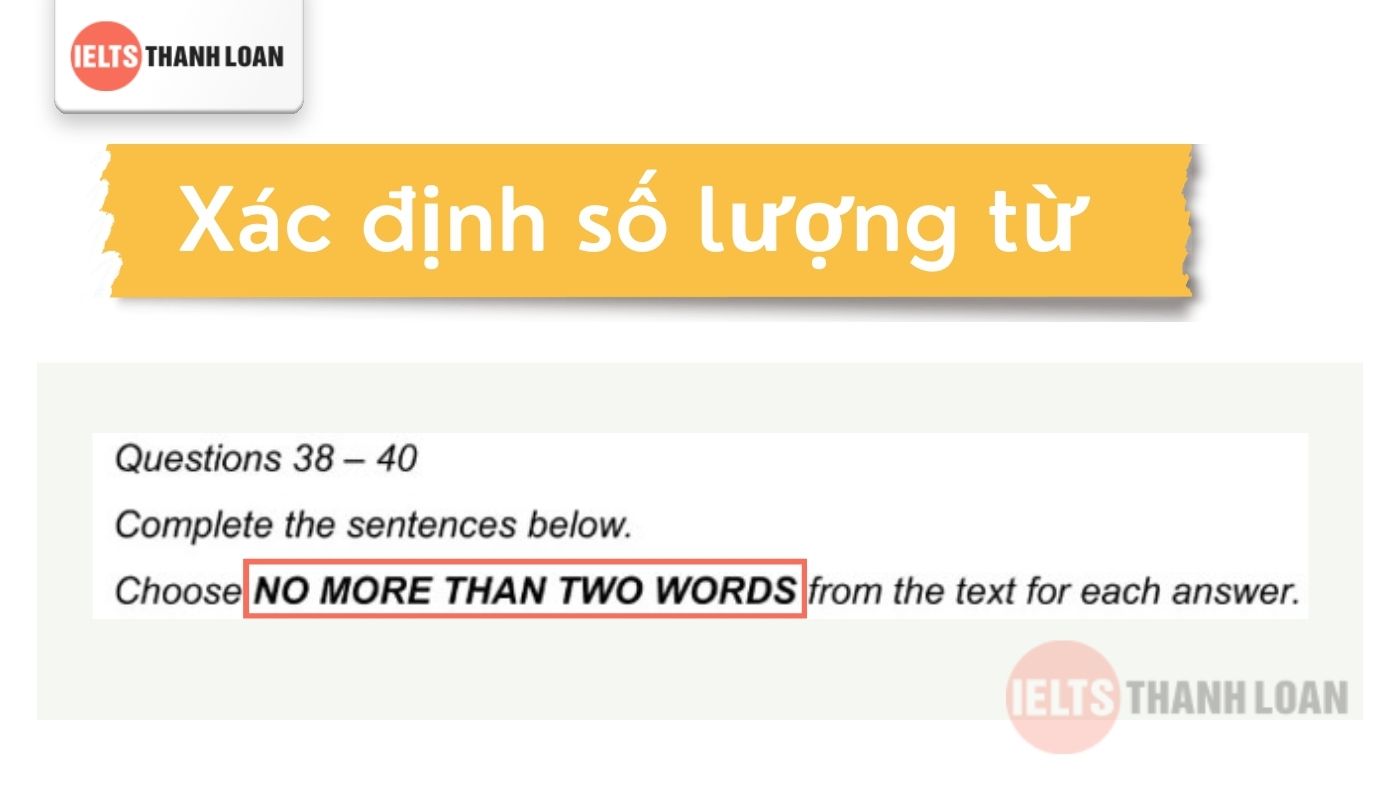
Đọc kỹ yêu cầu đề bài và xác định số lượng từ tối đa được phép điền vào ô trống
Bước 2: Phân tích câu hỏi và nhận diện từ khóa
Mỗi câu hỏi trong bài Sentence Completion IELTS Reading thường chứa một hoặc nhiều khoảng trống mà bạn cần điền thông tin. Để làm tốt, bạn hãy dành thời gian đọc kỹ từng câu hỏi và xác định loại từ cần điền (như danh từ, động từ, tính từ). Đồng thời, gạch chân những từ khóa quan trọng trong câu để dễ dàng tìm ra đoạn văn chứa thông tin tương ứng.
Ví dụ câu hỏi: “The government has introduced a new policy to reduce _____ pollution in cities.”
→ Phân tích câu hỏi:
- Từ khóa: “government,” “introduced a new policy,” “reduce,” “pollution,” “in cities.”
- Loại từ cần điền: Bạn cần một danh từ (loại ô nhiễm) để điền vào khoảng trống. Dựa trên cấu trúc câu, từ cần điền sẽ mô tả loại ô nhiễm.
→ Dự đoán câu trả lời: Từ cần điền có thể là một loại ô nhiễm như “air,” “water,” hoặc “noise” tùy thuộc vào nội dung của đoạn văn trong bài đọc.
Bước 3: Dự đoán loại từ hoặc cụm từ cần điền
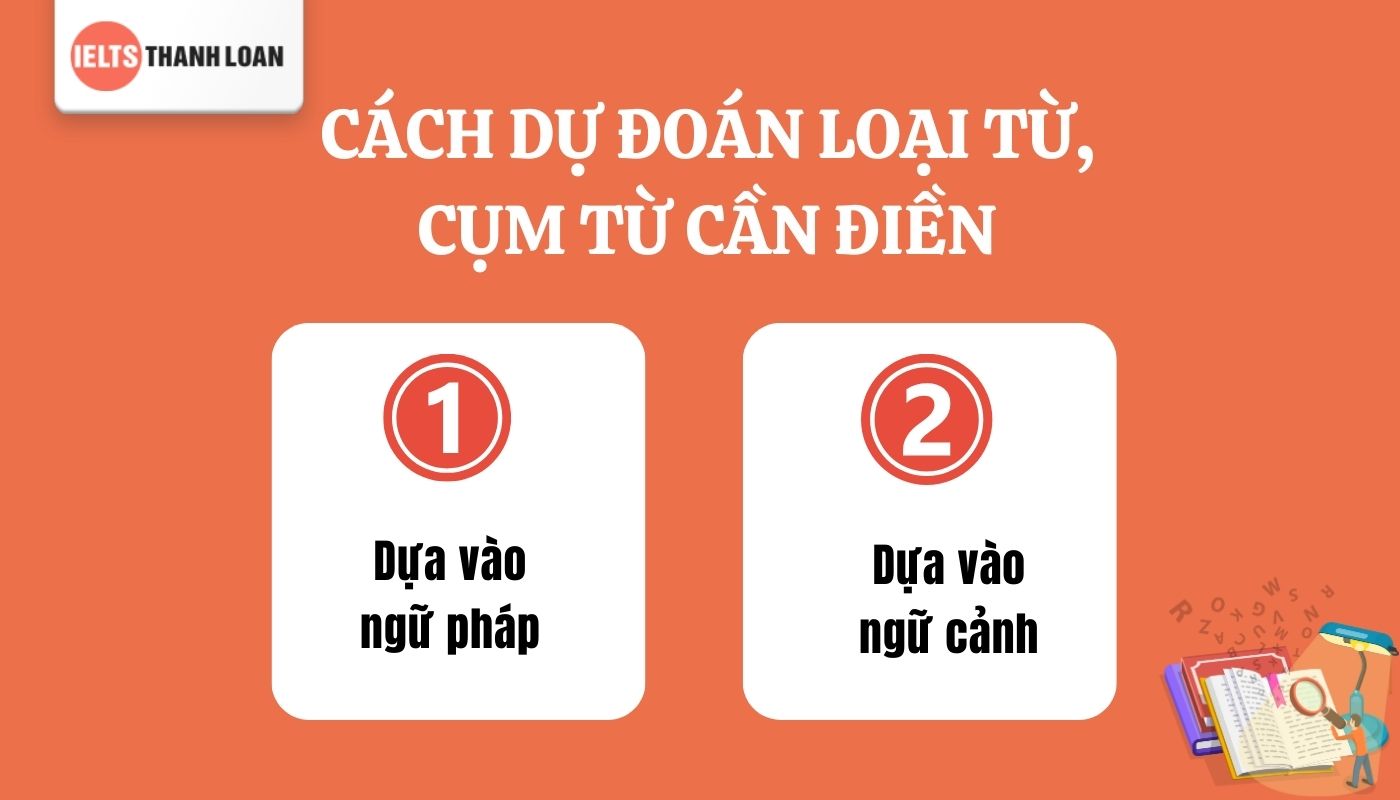
Cách phỏng đoán các loại từ, cụm từ cần điền
Sau khi phân tích câu hỏi và nhận diện từ khóa, bước tiếp theo, thí sinh cần đưa ra dự đoán loại từ hoặc cụm từ cần điền vào chỗ trống. Bạn có thể dựa vào cấu trúc ngữ pháp và ngữ cảnh của câu văn để xác định chính xác loại từ cần điền. Ví dụ:
- Dựa vào ngữ pháp: Xem xét từ đứng trước và sau chỗ trống để xác định từ loại. Chẳng hạn, nếu trước chỗ trống là một mạo từ như “a” hoặc “an”, thì từ cần điền có thể là một danh từ. Nếu trước chỗ trống là động từ, thì từ cần điền có thể là trạng từ.
- Dựa vào ngữ cảnh: Hiểu nội dung tổng thể của câu và đoạn văn sẽ giúp bạn phỏng đoán ý nghĩa của từ hoặc cụm từ cần điền. Điều này giúp bạn điền từ phù hợp về cả ý nghĩa lẫn cấu trúc ngữ pháp.
Ví dụ câu hỏi: “The company aims to _____ its market share by the end of the year.”
→ Loại từ cần điền: Động từ (vì đứng sau “to” và trước tân ngữ “market share”).
→ Dự đoán: Một động từ chỉ hành động tăng trưởng hoặc mở rộng như “increase,” “boost,” hoặc “expand.”
Bước 4: Tìm kiếm thông tin chính xác trong bài đọc
Để trả lời câu hỏi dạng Sentence Completion IELTS, thí sinh nên áp dụng phương pháp Scanning – kỹ thuật quét nhanh bài đọc để tìm kiếm thông tin cụ thể. Thay vì đọc từng câu chữ, bạn chỉ cần tập trung xác định từ khóa hoặc cụm từ liên quan đến câu hỏi để tìm đáp án chính xác.
Bước 5: Chọn đáp án
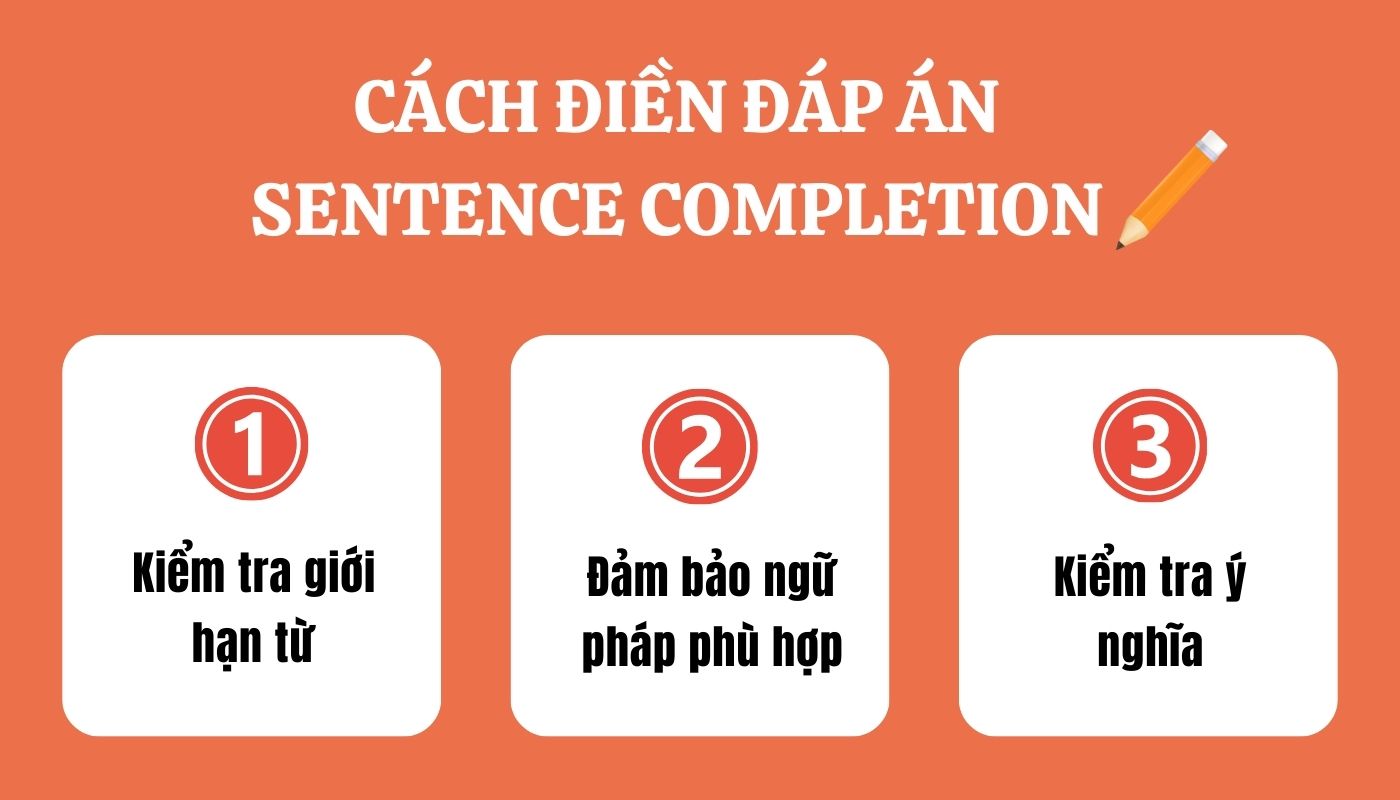
Các bước điền đáp án cho câu hỏi Sentence Completion IELTS
Sau khi xác định được đoạn văn chứa thông tin liên quan, thí sinh cần đọc kỹ lại câu hỏi và chọn từ hoặc cụm từ phù hợp để điền vào chỗ trống. Ở bước này, bạn cần chú ý đến các yếu tố sau:
- Kiểm tra giới hạn từ: Đảm bảo từ cần điền không vượt quá số lượng từ mà đề bài yêu cầu, chẳng hạn như “ONE WORD ONLY” hay “NO MORE THAN TWO WORDS“
- Đảm bảo ngữ pháp phù hợp: Từ được chọn phải phù hợp với cấu trúc ngữ pháp của câu văn hoàn chỉnh.
- Kiểm tra ý nghĩa: Đáp án phải phù hợp về mặt ngữ nghĩa với câu hỏi và đảm bảo câu hoàn chỉnh có nghĩa hợp lý.
*Bài mẫu hướng dẫn cách làm bài IELTS Reading Sentences Completion:
ĐỀ BÀI
The Romans Reveal Their Secrets
A
As Katherine Sheen rested on the banks of Hensham river on 3 August 2005, her gaze fell upon a small dirt-covered object amongst a tangle of tree roots. Cleaning away the soil, she realized it was a leather pouch. It fell apart as Katherine opened it, and the items inside fell to the ground. Although her university degree merely touched on the Roman occupation of ancient Britain, providing a very general overview of everyday activities, once she’d rubbed off some the dirt, Katherine immediately identified the coins in her hand as coming from that era (Q1). Despite their discoloration, Katherine had no doubt they were historically significant. As soon as she got home, she informed the police of her find.
B
That might have been the end of the story – except for the fact that the farmer who owned adjacent field then mentioned the lines of large stones his plough kept running into. By mid-August, with the farmer’s permission, a team of archaeologists, led by Professor Kevin Durrand, were camped out in the field. Durrand had previously worked on other projects where pieces of ancient pottery and the discovery of an old sword had led archaeologists to unearth sizeable Roman settlements. He was keen to start excavations at Hensham, and had got funding for a three-month dig. What his team eventually discovered, three weeks into excavations, were the remains of the outer walls of a Roman villa. As many Romans in Britain simply lived in wooden houses with thatched roofs, the family that occupied the villa must have been very wealthy. As the team continued their work, they looked for evidence that might indicated whether the villa had been attacked and purposely demolished, or fallen into such a poor state that it eventually collapsed. Looking at the way a set of slate roof tiles had fallen to the ground, they decided on the latter (Q4). What caused the noble Roman family and their servants to abandon the villa remains open to speculation. Another find was six blue beads, crafted from glass, which the archaeologists speculated were part of a necklace. Durrand has previously found gold bracelets on other sites, but for him the beads are no less significant. ‘Every find contributes to the story’, he says.
C
On the outer western wall, the archaeologists uncovered number of foundation stones. On one is carved what the archaeologists made out to be a Latin inscription. But as the stone itself has endured centuries of erosion, the team has yet to work out what it says (Q6). Another find was a section of traditional Roman mosaic. Although incomplete, enough pieces remain to show a geometrical pattern and stylized fish. From this, Durrand assumes that a bath house would have been a feature of the villa. While his team have so far not found any hard proof of this, Durrand is confident it will turn out to be the case (Q7).
D
Something that team particularly excited about is evidence of a heating system, which would have served the Roman family and their visitors well in winter months. Although much of the system has long since crumbled at Hensham, Durrand and his team believe it would have been based on a typical Roman hypocaust; they have created a model for visitors to see. The furnace that produced the hot air needed to be kept burning all the time, a task that would have fallen to the villa’s slaves. As large branches would have taken too long to produce the heat required, it is more likely that twigs would have been gathered from surrounding woodland instead (Q8). Another fuel source used in some Roman hypocausts was charcoal, but evidence for this at Hensham has not presented itself. The underfloor space was made by setting the floor on top of piles of square stones. Known as pilae, these stones stood approximately two feet high. The gap this created meant that the hot air coming out of the furnace was not trapped and restricted. Instead its distribution around the pilae and under the floor was free flowing (Q9). Floor tiles were not placed directly onto the pilae but separated by a layer of concrete, or at least a primitive version of it (Q10). This would have made the whole structure more solid, and helped reduce the risk of fire spreading to upper levels. The walls of the rooms above heating system were made of bricks, but the key point here is that they were hollow, in order to allow heat to rise around the rooms and provide insulation (Q11). Some have been recovered from the Hensham villa and are now undergoing preservation treatment.
E
Another feature of the heating system that archaeologists have identified at Hensham was its clay pipes. These were cleverly built into the wall so as not to take up space. The principal reason for including the pipes was to let out air through a vent in the roof once it had cooled down. What the Romans may not have realised, however, was that gas produced by the burning fuel was expelled in this way too. In high doses, it could have been lethal if it had leaked into the upper levels (Q12). Inside the rooms in the villa, a layer of plaster would have been applied to the walls and painted in rich colours. Sadly, none of the original plaster at Hensham still exists. However, some of the tiles that the family would have walked on have survived. They would certainly have felt warm underfoot and helped generate an indoor climate that the family could relax in (Q13). In its day, the Hensham hypocaust would have been a remarkable piece of engineering.
CÂU HỎI
| Questions 8-13
Label the diagram below. Choose NO MORE THAN TWO WORDS from the passage for each answer. Write your answers in boxes 8-13 on your answer sheet. 8. _______ were constantly added to the furnace by slaves. 9. The height of of the pilae helped with the ______ of air produced by the furnace. 10. Builders used ______ as a material for this part. 11. The use of _____ meant walls were well-insulated. 12. Cold air escaped from pipes, as well as dangerous ______. 13. Fitted surfaces created a comfortable ______. |
PHÂN TÍCH ĐÁP ÁN
Câu hỏi 8: _______ were constantly added to the furnace by slaves.”
Dịch câu hỏi: _______ liên tục bị nô lệ cho vào lò.
Từ loại cần điền: danh từ số nhiều (vì chỗ cần điền đứng ngay trước động từ to be ”were’)
Thông tin liên quan: Nằm ở Đoạn D
“…The furnace that produced the hot air needed to be kept burning all the time, a task that would have fallen to the villa’s slaves. As large branches would have taken too long to produce the heat required, it is more likely that twigs would have been gathered from surrounding woodland instead…”
Phân tích: Đoạn D cung cấp thông tin rằng các cành cây con (twigs) đã được thu gom từ khu rừng xung quanh và sử dụng làm nhiên liệu để duy trì ngọn lửa cho lò. Mặc dù có khả năng một số lò sưởi La Mã sử dụng than củi, nhưng không có bằng chứng cho thấy nhiên liệu này đã được sử dụng tại Hensham. Thay vào đó, các cành cây nhỏ được sử dụng để tạo ra nhiệt cần thiết, đảm bảo lò luôn cháy. Việc liên tục thêm cành cây vào lò là nhiệm vụ của nô lệ (slaves) ở căn biệt thự. Điều này giải thích rằng cành cây sẽ thường xuyên được đưa vào lò để giữ nhiệt độ ổn định.
→ Đáp án chính xác: twigs
Câu hỏi 9: The height of of the pilae helped with the ______ of air produced by the furnace.
Dịch câu hỏi: Chiều cao của trụ cột giúp ______ không khí do lò tạo ra.
Từ loại cần điền: danh từ (vì chỗ cần điền đứng sau ‘the’)
Thông tin liên quan: Nằm ở Đoạn D
“…Known as pilae, these stones stood approximately two feet high. The gap this created meant that the hot air coming out of the furnace was not trapped and restricted. Instead its distribution around the pilae and under the floor was free flowing…”
Phân tích: Đoạn D giải thích rằng các trụ cột, được gọi là pilae, có chiều cao khoảng 2 foot và tạo ra một khoảng trống giúp không khí nóng thoát ra từ lò không bị mắc kẹt, mà thay vào đó được phân tán tự do xung quanh pilae và dưới sàn.
Như vậy, khoảng trống do chiều cao của pilae tạo ra giúp cho việc phân tán khí nóng diễn ra suôn sẻ. Từ cần điền trong câu phải là danh từ thể hiện quá trình phân tán của không khí do lò tạo ra.
→ Đáp án chính xác: distributions
Câu hỏi 10: Builders used ______ as a material for this part.
Dịch câu hỏi: Các nhà xây dựng đã sử dụng ______ làm vật liệu cho phần này.
Từ loại cần điền: danh từ (vì chỗ cần điền đứng sau “used”)
Thông tin liên quan: Nằm ở Đoạn D
“…Floor tiles were not placed directly onto the pilae but separated by a layer of concrete, or at least a primitive version of it…”
Phân tích: Đoạn D giải thích rằng các viên gạch sàn không được đặt trực tiếp lên pilae mà có một lớp ngăn cách ở giữa, được làm từ bê tông hoặc ít nhất là một phiên bản nguyên thủy của nó.
→ Đáp án chính xác: concrete
⇒ Tham khảo thêm cách trả lời câu hỏi Sentence Completion tại Bài dịch & giải IELTS Reading trong IELTS Trainer 2 Test 4 từ IELTS Thanh Loan.
Mẹo làm bài Sentence Completion trong IELTS Reading hiệu quả
Sentence Completion IELTS Reading Tips
Đối với dạng câu hỏi IELTS Reading Sentence Completion, thí sinh có thể áp dụng một số tips hữu ích sau đây để nâng cao kỹ năng làm bài và cải thiện điểm số:
- Chú ý đến số lượng từ cho phép điền vào chỗ trống. Điều này rất quan trọng để đảm bảo bạn không vi phạm yêu cầu của đề bài.
- Trước khi đọc đoạn văn, thí sinh nên đọc lướt các câu hỏi để hình dung nội dung cần tìm.
- Khi đọc các câu hỏi, hãy gạch chân những từ khóa quan trọng như tên riêng, số, ngày tháng hoặc địa điểm. Những từ này sẽ giúp bạn dễ dàng tìm kiếm đoạn văn bản liên quan trong bài đọc.
- Khi tìm thấy từ khóa tương ứng trong bài đọc, bạn hãy đọc kỹ những nội dung liên quan đến đoạn văn bản vì câu trả lời thường nằm trong các câu văn gần đó.
- Ưu tiên tìm câu trả lời cho câu hỏi đầu tiên, vì các câu hỏi thường được sắp xếp theo thứ tự tương ứng với nội dung trong văn bản.
- Đảm bảo những câu đã hoàn thành phải đúng chính xác về mặt ngữ pháp. Nếu không, câu trả lời của bạn sẽ không được công nhận dù đã điền đúng từ.
- Nếu bạn gặp khó khăn trong việc tìm đáp án, hãy chuyển sang câu hỏi tiếp theo. Đừng nên dành quá nhiều thời gian cho một câu hỏi để tránh việc không hoàn thành bài thi đúng giờ.
Bài tập IELTS Reading Sentence Completion
Nhằm giúp học viên hiểu rõ hơn về cách làm bài Sentence Completion IELTS Reading, IELTS Thanh Loan đã tổng hợp nguồn bài tập Sentence Completion chất lượng được trích từ các sách luyện đề uy tín, phản ánh chính xác format và yêu cầu của kỳ thi Reading thực tế.
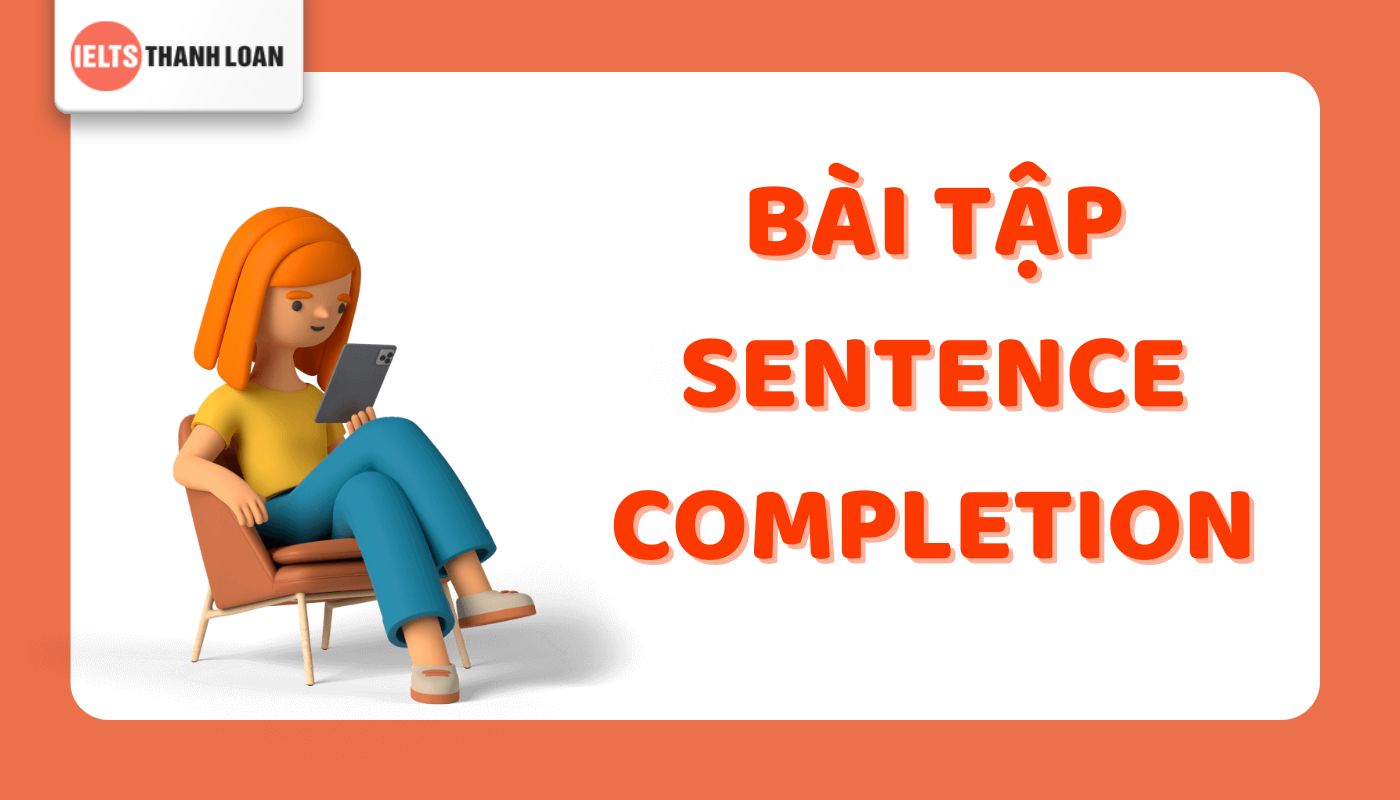
Tổng hợp bài tập Sentence Completion kèm phân tích đáp án cụ thể
ĐỀ BÀI
The Truth About Lying
A
An area of scientific study that caught the public imagination during the 1970s involved a gorilla called Koko. Animal psychologist Francine Patterson claimed to have taught Koko a simplified form of American Sign Language, and through singing, Koko could apparently communicate basic ideas such as ‘food’ and ‘more’, as well as concepts such as ‘good’ and ‘sorry’. But Koko also used signs to blame other people for damage she had caused herself. While today there is some dispute about whether Koko truly understood the meaning of all the signs she made, Professor Karen Goodger believes she was certainly capable of dishonesty. ‘People use words to lie, but for animals with higher brain functions, there’s also a higher probability that they’ll demonstrate manipulative behaviors (Q21). We see this not just in gorillas, but in other creatures with a large neocortex.
B
Human societies may appear to disapprove of lying, but that doesn’t mean we don’t all do it. And it seems that the ability, or at least the desire to deceive, starts from an early age. In one study run by psychologist Kang Lee, children were individually brought into a laboratory and asked to face a wall. They were asked to guess what toy one of Lee’s fellow researchers had placed on a table behind them – for example, a fluffy cat or dog. The researcher would then announce they had to leave the lab to take a phone call, reminding the child not to turn around. The research team were well aware that many children would be unable to resist peeking at the toy (Q18). Secret cameras showed that 30% of two-year-old children lied about not looking. This went up to 50% for three-year-olds and almost 80% of eight- year-olds. Interestingly, whereas the younger children simply named the toy and denied taking a peek, the older ones came up with some interesting reasons to explain how they had identified the toy correctly. Lee is reassured by this trend, seeing it as evidence in each case that the cognitive growth of a human child is progressing as it should (Q22). Parents, of course, may not be so pleased.
C
Adults, however, can hardly criticise children. According to Professor Richard Wiseman, it appears that adults typically tell two major lies per day, and that one third of adult conversations contain an element of dishonesty. Other research indicates that spouses lie in one out of every 10 interactions (Q14). This probably comes as no surprise to Tali Sharot at University College London, who has run a series of experiments proving we become desensitised to lying over time. She has found that while we might initially experience a sense of shame about small lies, this feeling eventually wears off. The result, Sharot has found, is that we progress to more serious ones (Q19).
D
Other researchers, including Tim Levine at the University of Alabama, have analysed our motives for lying. By far the most common is our desire to cover up our own wrongdoing. Second to this are lies we tell to gain economic advantage – we might lie during an interview to increase the chances of getting a job. Interestingly, ‘white lies’, the kind we tell to avoid hurting people’s feelings, account only for a small percentage of our untruths (Q17). But if we recognise our own tendency to lie, why don’t we recognise it in others? Professor Goodger thinks it has something to do with our strong desire for certain information we hear to be true, even when we might suspect it isn’t. This is because we might be ‘comforted by others’ lies or excited by the promise of a good outcome’, Goodger says (Q20).
E
We might not expect ordinary people to be good at recognising lies, but what about people whose job it is to investigate the behavior of others? Paul Erkman is a psychologist from the University of California. As part of his research into deception, he has invited a range of experts to view videos of people telling lies and of others telling the truth. Among the experts have been judges, psychiatrists and people who operate polygraph machines for police investigations (Q15). None of these experts have shown they can detect dishonestly any better than people without their experience. Part of the problem is that so many myths still prevail about ‘give-away signs’ indicating that someone is lying.
F
A common claim, for example, is that liars won’t look people in the eye during their explanations or while being questioned. Another is that they are likely to gesture as they tell their story, but so frequently that it seems unnatural – as if they are trying to convince others of their sincerity (Q23). However, many researchers have come to reject these ideas, suggesting a more effective approach is to listen to their narration style. A difficulty that liars face is having to remember exactly what they said, which is why they don’t provide as many details as a person giving an honest account would (Q24). It is also typical of liars to mentally rehearse their story, and this is why one stage follows another in apparently chronological fashion (Q25). Honest stories, however, feature revisions and repetition. Recent research has also disproved the widely believed notion that liars have a habit of fidgeting in their seats. Rather, it seems that they keep still, especially in the upper body, possibly hoping to give the impression of self-assurance (Q26). Liars also put some psychological distance between themselves and their lies. For that reason, they avoid the use of ‘I’ when narrating their stories. The reverse is true, however, when people write fake reviews, say, a hotel or restaurant. In these instances, ‘I’ features again and again as they attempt to convince use that their experience was real (Q16).
CÂU HỎI
| Questions 23-26
Complete the summary below. Choose ONE WORD ONLY from the passage for each answer. Write your answers in boxes 23-26 on your answer sheet. Signs that someone is lying It is commonly claimed that people who are lying will avoid making eye contact with others and will 23……… a lot. Many researchers now disagree with these claims. Instead they analyze the way people tell their stories. For example, liars tend to offer fewer 24……… than people who are telling the truth. However, each 25……… of their story seems to be in order, because they have carefully planned what they want to say. And contrary to what many people believe, liars often remain 26……… as they lie, perhaps in the belief that they will come across as more confident than they really are. |
ĐÁP ÁN
Câu hỏi 23: “It is commonly claimed that people who are lying will avoid making eye contact with others and will ……… a lot.”
→ Thông tin liên quan: Đoạn F
“…A common claim, for example, is that liars won’t look people in the eye during their explanations or while being questioned. Another is that they are likely to gesture as they tell their story, but so frequently that it seems unnatural – as if they are trying to convince others of their sincerity…”
→ Từ cần điền: gesture
Câu hỏi 24: “For example, liars tend to offer fewer……… than people who are telling the truth.”
→ Thông tin liên quan: Đoạn F
“…A difficulty that liars face is having to remember exactly what they said, which is why they don’t provide as many details as a person giving an honest account would…”
→ Từ cần điền: details
Câu hỏi 25: “However, each ……… of their story seems to be in order, because they have carefully planned what they want to say.”
→ Thông tin liên quan: Đoạn F
“…It is also typical of liars to mentally rehearse their story, and this is why one stage follows another in apparently chronological fashion…”
→ Từ cần điền: stages
Câu hỏi 26: “And contrary to what many people believe, liars often remain ……… as they lie, perhaps in the belief that they will come across as more confident than they really are.”
→ Thông tin liên quan: Đoạn F
“…Recent research has also disproved the widely believed notion that liars have a habit of fidgeting in their seats. Rather, it seems that they keep still, especially in the upper body, possibly hoping to give the impression of self-assurance…”
→ Từ cần điền: still
Học IELTS Online tại IELTS Thanh Loan – Cam kết band điểm đầu ra
Để nâng cao kỹ năng làm bài IELTS Reading cũng như các kỹ năng liên quan khác, học viên có thể cân nhắc tham gia các khóa luyện thi IELTS Online tại IELTS Thanh Loan. Được thiết kế đặc biệt nhằm giúp người học làm quen với các dạng đề thi IELTS theo 4 kỹ năng, khóa học IELTS trực tuyến không chỉ cung cấp các kiến thức cơ bản, nâng cao cho từng kỹ năng mà còn hướng dẫn chiến lược làm bài hiệu quả với nội dung cô đọng, thực chiến nhất.
Tham gia khóa luyện thi IELTS Online tại IELTS Thanh Loan, bạn sẽ được rèn luyện toàn diện cả 04 kỹ năng cùng cam kết band điểm chuẩn đầu ra với lộ trình học tập bài bản, khoa học như sau:
- Nắm vững cấu trúc bài thi IELTS cho 04 kỹ năng: Học viên sẽ được tìm hiểu chi tiết về cấu trúc bài thi của 4 kỹ năng: Nghe, Nói, Đọc, Viết. Theo đó, cô Thanh Loan – Giáo viên dạy IELTS giỏi với kinh nghiệm 10+ năm giảng dạy sẽ hướng dẫn cách trả lời các dạng câu hỏi khác nhau, chia sẻ mẹo hay và kinh nghiệm làm bài thi hiệu quả.
- Rèn luyện ngữ pháp, từ vựng, phát âm: Khóa học IELTS Online tập trung phát triển vốn từ vựng Academic liên quan đến các chủ đề phổ biến trong kỳ thi IELTS. Đồng thời, học viên sẽ được chỉnh sửa và rèn luyện phát âm chuẩn IPA, tạo tiền đề chinh phục điểm số cao trong phần thi Speaking & Writing.
- Luyện đề IELTS sát thật & phát triển kỹ năng phòng thi: Bên cạnh trau dồi kiến thức lý thuyết, học viên còn được thực hành luyện đề thường xuyên với kho đề thi IELTS mẫu được cập nhật liên tục hàng năm, đảm bảo tính sát thực và chuẩn format đề thi thực tế. Không những thế, khóa ôn thi IELTS Online còn trang bị cho người học kỹ năng quản lý thời gian và tâm lý tự tin nhất khi đi thi.
- Hỗ trợ đăng ký thi IELTS: Với dịch vụ giáo dục tử tế từ tâm, học viên sau khi hoàn thành khóa IELTS Online sẽ được trung tâm hỗ trợ tận tình trong quy trình đăng ký thi IELTS, giúp bạn yên tâm tập trung ôn luyện mà không phải lo lắng về thủ tục phức tạp.
Qua bài viết trên đây, IELTS Thanh Loan đã tổng hợp và chia sẻ những chiến lược, lưu ý quan trọng về cách làm bài IELTS Reading Sentence Completion đạt band điểm cao. Hy vọng những thông tin hữu ích này sẽ giúp bạn có thêm kiến thức về cách làm bài Sentence Completion, cũng như các tips trả lời câu hỏi chuẩn xác. Nếu bạn quan tâm hoặc cần tham khảo thêm thông tin về khóa học IELTS Online, đừng ngần ngại liên hệ ngay đến IELTS Thanh Loan để được tư vấn về học phí và lộ trình luyện thi nhé!














